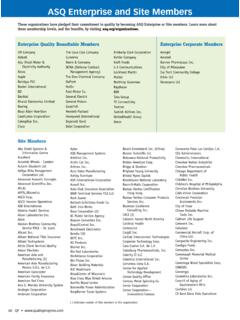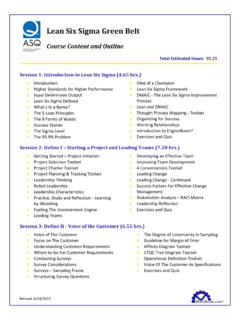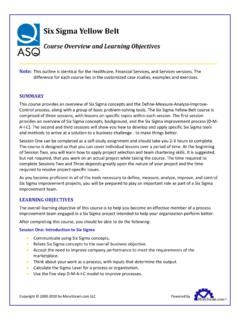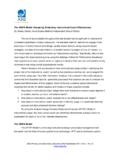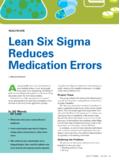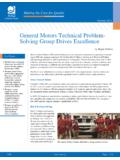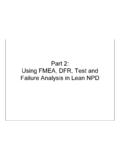Transcription of CSSBB SIX SIGMA BLACK BELT CERTIFIED - ASQ
1 Quality excellence to enhance your career and boost your organization s bottom SIX SIGMA BLACK BELTCSSBB2 CERTIFIED Six SIGMA BLACK BeltCertification from ASQ is considered a mark of quality excellence in many industries. It helps you advance your career and boosts your organization s bottom line through your mastery of quality skills. Becoming CERTIFIED as a Six SIGMA BLACK Belt confirms your commitment to quality and the positive impact it will have on your certification candidate is required to pass a written examination that consists of multiple-choice questions that measure comprehension of the body of knowledge. 3 CERTIFIED Six SIGMA BLACK BeltThe CERTIFIED Six SIGMA BLACK Belt ( CSSBB ) is a professional who can explain Six SIGMA philosophies and principles, including supporting systems and tools. A BLACK Belt should demonstrate team leadership, understand team dynamics, and assign team member roles and responsibilities. BLACK Belts have a thorough understanding of all aspects of the DMAIC model in accordance with Six SIGMA principles.
2 They have basic knowledge of lean enterprise concepts, are able to identify nonvalue-added elements and activities, and are able to use specific Delivered - the CSSBB examination is a one-part, 165-question, four-and-a-half-hour exam and is offered in English only. One hundred and fifty questions are scored and 15 are and Pencil The CSSBB examination is a one-part, 150-question, four-hour exam and is offered in English only. Experience RequiredSix SIGMA BLACK Belt requires two completed projects with signed affidavits, or one completed project with a signed affidavit and three years of work experience, in one or more areas of the Six SIGMA BLACK Belt Body of M AT IO NFor comprehensive exam information on Six SIGMA BLACK Belt certification, visit Six SIGMA BLACK Belt4 CERTIFIED Six SIGMA BLACK BeltMinimum ExpectationsOrganization-wide Planning and Deployment Will understand how to deploy Six SIGMA within a project. Will be able to implement tools and techniques to deploy strategic directions for initiatives.
3 Will understand the roles and responsibilities for Six SIGMA projects and how each group influences project deployment, and will be able to support communications about the project deployment. Will be able to apply operational change management techniques within their defined scope or Process Management and Measures Will be able to define various types of benchmarking. Will be able to describe various types of performance measures, and select an appropriate financial measure for a given situation and calculate its Management Will understand the components and techniques used in managing teams, including time management, planning and decision-making tools, team formation, motivational techniques and factors that demotivate a team, and performance evaluation and reward. Will be able to describe elements that can result in a team s success. Will be able to use appropriate techniques to overcome various group dynamics Will be able to select data collection methods and collect voice of the customer data, and use customer feedback to determine customer requirements.
4 Will understand the elements of a project charter (problem statement, scope, goals, etc.) and be able to use various tools to track the project Will be able to define and use process flow metrics and analysis tools to indicate the performance of a process. Will be able to develop and implement data collection plans, and use techniques in sampling, data capture, and processing tools. Will be able to define and describe measurement system analysis tools. Will apply basic probability concepts and understand various distributions. Will be able to calculate statistical and process capability Will be able to analyze the results of correlation and regression analyses. Will be able to define multivariate tools. Will be able to perform hypothesis tests for means, variances, and proportions, and analyze their Six SIGMA BLACK Belt Will understand the components and concepts for ANOVA, chi square, contingency tables, and nonparametric tests. Will understand the elements and purpose of FMEA and use root cause analysis tools.
5 Will be able to identify and interpret the seven classic wastes. Will be able to use gap analysis Will be able to define and apply design of experiments (DOE) principles, and distinguish among the various types of experiments. Will be able to apply various lean tools and techniques to eliminate waste and reduce cycle time. Will understand how to implement an improved process and how to analyze and interpret risk Will be able to apply, use, and analyze the various statistical process control (SPC) techniques. Will understand total productive maintenance (TPM) and visual factory concepts. Will be able to develop control plans and use various tools to maintain and sustain For Six SIGMA (DFSS) Framework and Methodologies Will understand common DFSS and DFX methodologies, and elements of robust Six SIGMA BLACK BeltI. Organization-Wide Planning and Deployment (Questions 12)A. Organization-wide Considerations1. Fundamentals of Six SIGMA and lean methodologies Define and describe the value, foundations, philosophy, history, and goals of these approaches, and describe the integration and complementary relationship between them.
6 (Understand)2. Six SIGMA , lean, and continuous improvement methodologiesDescribe when to use Six SIGMA instead of other problem-solving approaches, and describe the importance of aligning Six SIGMA objectives with organizational goals. Describe screening criteria and how such criteria can be used for the selection of Six SIGMA projects, lean initiatives, and other continuous improvement methods. (Apply)3. Relationships among business systems and processesDescribe the interactive relationships among business systems, processes, and internal and external stakeholders, and the impact those relationships have on business systems. (Understand)4. Strategic planning and deployment for initiativesDefine the importance of strategic planning for Six SIGMA projects and lean initiatives. Demonstrate how hoshin kanri (X-matrix), portfolio analysis, and other tools can be used in support of strategic deployment of these projects. Use feasibility studies, SWOT analysis (strengths, weaknesses, opportunities, and threats), PEST analysis (political, economic, social, and technological) and contingency planning and business continuity planning to enhance strategic planning and deployment.
7 (Apply)Topics in this body of knowledge (BoK) include additional detail in the form of subtext explanations and the cognitive level at which test questions will be written. This information will provide guidance for the candidate preparing to take the exam. The subtext is not intended to limit the subject matter or be all-inclusive of what might be covered in an exam. It is meant to clarify the type of content to be included in the exam. The descriptor in parentheses at the end of each entry refers to the maximum cognitive level at which the topic will be tested. A complete description of cognitive levels is provided at the end of this OF KNOWLEDGEC ertified Six SIGMA BLACK Belt ( CSSBB )7 CERTIFIED Six SIGMA BLACK BeltB. Leadership1. Roles and responsibilities Describe the roles and responsibilities of executive leadership, champions, sponsors, process owners, Master BLACK Belts, BLACK Belts, and Green Belts in driving Six SIGMA and lean initiatives. Describe how each group influences project deployment in terms of providing or managing resources, enabling changes in organizational structure, and supporting communications about the purpose and deployment of the initiatives.
8 (Understand)2. Organizational roadblocks and change managementDescribe how an organization s structure and culture can impact Six SIGMA projects. Identify common causes of Six SIGMA failures, including lack of management support and lack of resources. Apply change management techniques, including stakeholder analysis, readiness assessments, and communication plans to overcome barriers and drive organization-wide change. (Apply)II. Organizational Process Management and Measures (10 Questions)A. Impact on StakeholdersDescribe the impact Six SIGMA projects can have on customers, suppliers, and other stakeholders. (Understand)B. BenchmarkingDefine and distinguish between various types of benchmarking, , best practices, competitive, collaborative, breakthrough. Select measures and performance goals for projects resulting from benchmarking activities. (Apply)C. Business Measures1. Performance measures Define and describe balanced scorecard, key performance indicators (KPIs), customer loyalty metrics, and leading and lagging indicators.
9 Explain how to create a line of sight from performance measures to organizational strategies. (Analyze)2. Financial measuresDefine and use revenue growth, market share, margin, net present value (NPV), return on investment (ROI), and cost benefit analysis (CBA). Explain the difference between hard cost measures (from profit and loss statements) and soft cost benefits of cost avoidance and reduction. (Apply)III. Team Management (18 Questions)A. Team Formation1. Team types and constraints Define and describe various teams, including virtual, cross-functional, and self-directed. Determine what team type will work best for a given a set of constraints, , geography, technology availability, staff schedules, time zones. (Apply)2. Team roles and responsibilitiesDefine and describe various team roles and responsibilities for leader, facilitator, coach, and individual member. (Understand)3. Team member selection criteriaDescribe various factors that influence the selection of team members, including the ability to influence, openness to change, required skill sets, subject matter expertise, and availability.
10 (Apply)4. Team success factorsIdentify and describe the elements necessary for successful teams, , management support, clear goals, ground rules, timelines. (Apply)8 CERTIFIED Six SIGMA BLACK BeltB. Team Facilitation 1. Motivational techniquesDescribe and apply techniques to motivate team members. Identify factors that can demotivate team members and describe techniques to overcome them. (Apply)2. Team stages of developmentIdentify and describe the classic stages of team development: forming, storming, norming, performing, and adjourning. (Apply)3. Team communicationDescribe and explain the elements of an effective communication plan, , audience identification, message type, medium, frequency. (Apply)4. Team leadership modelsDescribe and select appropriate leadership approaches ( , direct, coach, support, delegate) to ensure team success. (Apply)C. Team Dynamics 1. Group behaviorsIdentify and use various conflict resolution techniques ( , coaching, mentoring, intervention) to overcome negative group dynamics, including dominant and reluctant participants, groupthink, rushing to finish, and digressions.

